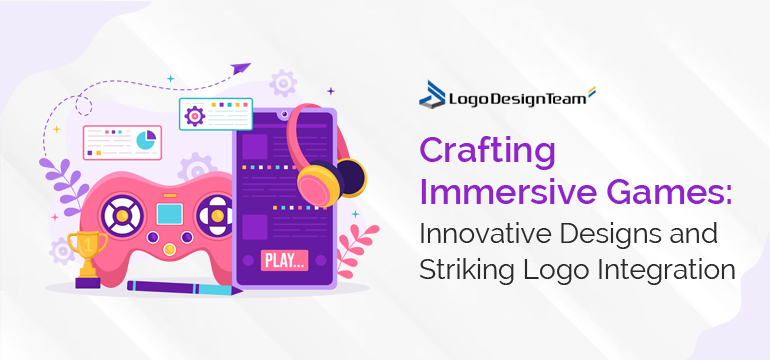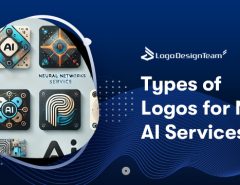Most people associate video games with fun, entertainment, and relaxation. But if you’ve ever played a game that was so immersive that it felt real—like you were actually part of the story—then you know how much more powerful they can be. With the right design choices, developers can make their games feel like they’re part of a larger world—and that’s when they become truly addictive.
In this post, we’ll explore how to squeeze even more out of your game’s design by integrating striking logos seamlessly into gameplay. You’ll learn how to craft user experiences that enhance engagement with your brand while also increasing interest in what comes next for your product line or company name.
Importance of Innovative Game Designs
In today’s world, there are many ways to experience games. From the classic board game to a console controller, there is no shortage of ways to get involved in immersive gaming. However, some of these methods have become more advanced than others and remain popular because of their ability to immerse players in new worlds with innovative designs.
If you’re looking for an effective way to engage your audience with your brand logo and message while also providing them with an immersive experience, then it’s important that your company has an understanding of what makes both innovative game design, especially when expertly crafted by industry leaders like KevuruGames, as well as immersive gaming, so powerful when combined together.
Elements of Immersive Gameplay
Immersive gameplay is a new frontier in game design. It’s a way to engage users in a more meaningful way and create a better user experience, which can lead to improved brand awareness and engagement.
Immersive games are those that embrace the full potential of virtual reality (VR) technology by offering players unique experiences that they would not be able to have otherwise. They’re sometimes called “experiences” instead of games because they aren’t structured like traditional video games with goals or objectives; instead, they focus on allowing players freedom within an immersive environment where they can explore without any constraints or limitations imposed by plotlines or gameplay mechanics.
Integrating Striking Logos in Game Design
The logo integration in your game is an important part of creating an immersive experience. There are several ways to integrate logos into gameplay, UI, and more.
Gameplay
Logos can be integrated into gameplay by having them appear on the screen during certain actions (for example, when a player hits a home run or scores a goal). If your game involves shooting arrows at targets and you’re using a bow company’s logo as part of that campaign, then it might make sense for arrows to shoot out of the bow when players click/tap on them. This creates an association between the brand and action in players’ minds a connection that will stay with them even after they’ve stopped playing.
UI
The look & feel of an interface (like an app store page) is often determined by what kind of content needs to be displayed within it and if there are any branding requirements from third parties involved too! So naturally this means there could be opportunities here too.
Significance of Logo Integration in User Experience
Logos are an important part of the user experience. They’re a form of branding, and they can be integrated into games in several ways to enhance the user experience. For example, you might want your logo to be visible onscreen at all times so that players can see it every time they play. In this way, your brand will be highly visible and recognizable by anyone who plays your game and even those who don’t!
Another way logos can enhance gameplay is through increased engagement: when players see their favorite brands integrated into their favorite games or sports teams’ uniforms (for example), they’ll feel more connected with those brands because those companies have established themselves as relevant parts of their lives through the mediums they love most video games and sports teams. This connection increases brand awareness among consumers while simultaneously driving up sales figures for both individual products sold within each franchise system as well as its overall value proposition as an entertainment option worth paying attention to over time.
Balancing Branding with User Engagement
Balancing branding with user engagement is a delicate art. You want to make sure your logo is visible and recognizable, but not obtrusive or distracting. Your logo should also be easy to read at all times and in all places, which can be challenging when designing for virtual reality (VR).
To ensure these goals are accomplished, we recommend using the following guidelines:
Logo size should be between 20-40% of screen size when viewed from afar (i.e., on a computer monitor). If you’re designing for mobile devices or VR headsets where users will have their faces close up against the screen, this percentage may increase slightly but not too much! The last thing you want is for people’s noses getting stuck in an endless loop trying to figure out what those letters mean!
Don’t forget about color contrast! Make sure there’s enough contrast between your logo’s colors and any background elements that might show through it; otherwise what was once readable becomes illegible at best or completely invisible at worst (and trust us: no one wants either scenario!).
Designing Logos for Immersive Gaming Experiences
When designing a logo for your immersive gaming experience, it’s important to remember that the logo is not just an image. It’s an integral part of the entire experience, especially when representing a unique identity like aaa gaming studio. In fact, in some cases, the logo can be one of the most important elements of your game!
Logos should be designed with three things in mind: visibility, clarity, and fit. Logos should clearly communicate who you are as an organization or person; they should also reflect your brand identity and style while fitting well within whatever environment they’re placed in (such as on a website or social media profile).
Technical Considerations for Seamless Logo Integration
When you’re building an immersive game, logo integration is important. If it’s done poorly, it can detract from the experience and feel like an afterthought. But if it’s done well with high-quality graphics and seamless integration your brand will stand out in a way that traditional marketing materials cannot.
To get started with your own logo integration project, start with these three steps:
- Use a high-quality logo design
- Use a high-quality game or app
- Choose an experienced designer
Future Trends in Game Design and Logo Integration
In the future, we’ll likely see more brands integrating their logos into immersive gaming experiences. As this field evolves and grows, it will become increasingly important to balance branding with user engagement. For example, if you want to integrate your logo into a game but also want players to enjoy the experience without being distracted by it, then you’ll need to consider how your design affects gameplay and how much information should be revealed at any given point in time.
For seamless logo integration (and other forms of marketing), technical considerations are paramount: How can we make sure our designs don’t interfere with gameplay? What kind of materials will they be printed on? How do we ensure that they’re easily visible when placed on various surfaces within an environment? And so forth these questions should be answered before any project begins so that no surprises crop up later down the line!
When it comes to logo integration, there are many ways to approach it. The key is finding the right balance between innovative game design and striking logo integration.
The first thing you should do is consider what makes your brand unique. What makes your product stand out from others? This will help inform how you integrate into an immersive gaming experience. By incorporating elements of the brand into gameplay, users can explore those aspects more closely in an engaging way that’s more personal than simply reading text on a website or watching ads on television.
Conclusion
We hope that you have gained a better understanding of how logo integration can add value to your game. By integrating striking logos into immersive gameplay, you can create a more engaging experience for your users while also increasing brand awareness and engagement. This is an exciting time for the gaming industry and we look forward to seeing what new innovations come next!




